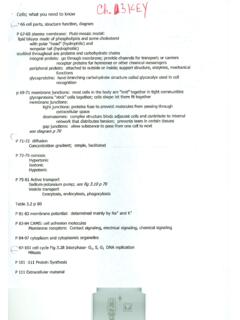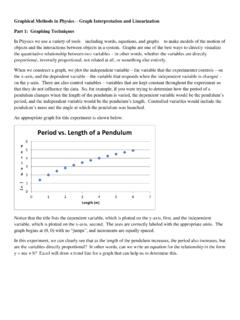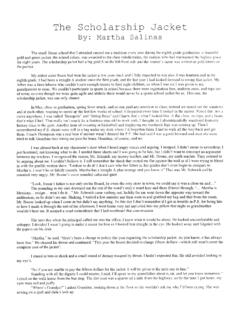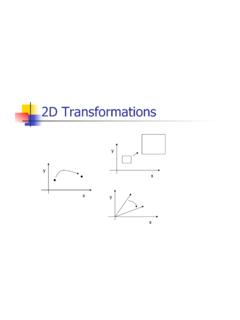Transcription of 2.1 Transformations of Quadratic Functions
1 Section Transformations of Quadratic Functions 47 Essential QuestionEssential Question How do the constants a, h, and k affect the graph of the Quadratic function g(x) = a(x h)2 + k?The parent function of the Quadratic family is f(x) = x2. A transformation of the graph of the parent function is represented by the function g(x) = a(x h)2 + k, where a 0. Learning CORE Identifying Graphs of Quadratic FunctionsWork with a partner. Match each Quadratic function with its graph. Explain your reasoning. Then use a graphing calculator to verify that your answer is g(x) = (x 2)2 b. g(x) = (x 2)2 + 2 c. g(x) = (x + 2)2 2d. g(x) = (x 2)2 2 e. g(x) = 2(x 2)2 f. g(x) = (x + 2)2 + 2A. 6 4 64 B. 6 4 64C. 6 4 64 D. 6 4 64E. 6 4 64 F. 6 4 64 Communicate Your AnswerCommunicate Your Answer 2.
2 How do the constants a, h, and k affect the graph of the Quadratic function g(x) = a(x h)2 + k? 3. Write the equation of the Quadratic function whose graph is shown at the right. Explain your reasoning. Then use a graphing calculator to verify that your equation is FOR STRUCTURETo be profi cient in math, you need to look closely to discern a pattern or structure. 6 4 of Quadratic Functions48 Chapter 2 Quadratic You Will LearnWhat You Will Learn Describe Transformations of Quadratic Functions . Write Transformations of Quadratic Transformations of Quadratic FunctionsA Quadratic function is a function that can be written in the form f(x) = a(x h)2 + k, where a 0. The U-shaped graph of a Quadratic function is called a Section , you graphed Quadratic Functions using tables of values.
3 You can also graph Quadratic Functions by applying Transformations to the graph of the parent function f(x) = x2. Quadratic function, p. 48 parabola, p. 48 vertex of a parabola, p. 50 vertex form, p. 50 PrevioustransformationsCore VocabularyCore VocabullarryCore Core ConceptConceptHorizontal Translations f(x) = x2 f(x h) = (x h)2yy = (x h)2,h < 0y = (x h)2,h > 0y = x2x shifts left when h < 0 shifts right when h > 0 Vertical Translations f(x) = x2 f(x) + k = x2 + kyy = x2 + k,k < 0y = x2 + k,k > 0y = x2x shifts down when k < 0 shifts up when k > 0 Translations of a Quadratic FunctionDescribe the transformation of f(x) = x2 represented by g(x) = (x + 4)2 1. Then graph each that the function is of the form xy462 22 6gfg(x) = (x h)2 + k.
4 Rewrite the function to identify h and (x) = (x ( 4))2 + ( 1) h k Because h = 4 and k = 1, the graph of g is a translation 4 units left and 1 unit down of the graph of ProgressMonitoring Progress Help in English and Spanish at the transformation of f(x) = x2 represented by g. Then graph each function. 1. g(x) = (x 3)2 2. g(x) = (x 2)2 2 3. g(x) = (x + 5)2 + 1 Section Transformations of Quadratic Functions 49 Core Core ConceptConceptRefl ections in the x-Axis f(x) = x2 f(x) = (x2) = x2xyy = x2y = x2fl ips over the x-axisHorizontal Stretches and Shrinks f(x) = x2 f(ax) = (ax)2xyy = x2y = (ax)2,0 < a < 1y = (ax)2,a > 1 horizontal stretch (away from y-axis) when 0 < a < 1 horizontal shrink (toward y-axis) when a > 1 Refl ections in the y-Axis f(x) = x2 f( x) = ( x)2 = x2xyy = x2y = x2 is its own refl ection in the Stretches and Shrinks f(x) = x2 a f(x) = ax2xyy = x2y = ax2,0 < a < 1y = ax2,a > 1 vertical stretch (away from x-axis) when a > 1 vertical shrink (toward x-axis)
5 When 0 < a < 1 transformations of Quadratic FunctionsDescribe the transformation of f(x) = x2 represented by g. Then graph each g(x) = 1 2 x2 b. g(x) = (2x)2 + 1 SOLUTIONa. Notice that the function is of the form g(x) = ax2, where a = 1 2 . So, the graph of g is a refl ection in the x-axis and a vertical shrink by a factor of 1 2 of the graph of f. xyfg2 22 2b. Notice that the function is of the form g(x) = (ax)2 + k, where a = 2 and k = 1. So, the graph of g is a horizontal shrink by a factor of 1 2 followed by a translation 1 unit up of the graph of 2 LOOKING FOR STRUCTUREIn Example 2b, notice that g(x) = 4x2 + 1. So, you can also describe the graph of g as a vertical stretch by a factor of 4 followed by a translation 1 unit up of the graph of f.
6 50 Chapter 2 Quadratic FunctionsMonitoring ProgressMonitoring Progress Help in English and Spanish at the transformation of f(x) = x2 represented by g. Then graph each function. 4. g(x) = ( 1 3 x ) 2 5. g(x) = 3(x 1)2 6. g(x) = (x + 3)2 + 2 Writing Transformations of Quadratic FunctionsThe lowest point on a parabola that opens up or the highest point on a parabola that opens down is the vertex. The vertex form of a Quadratic function is f(x) = a(x h)2 + k, where a 0 and the vertex is (h, k).f(x) = a(x h)2 + kk indicates a vertical indicates a reflection in the x-axis and/or a vertical stretch or indicates a horizontal translation. Writing a Transformed Quadratic FunctionLet the graph of g be a vertical stretch by a factor of 2 and a refl ection in the x-axis, followed by a translation 3 units down of the graph of f(x) = x2.
7 Write a rule for g and identify the 1 Identify how the Transformations affect the constants in vertex form. refl ection in x-axis a = 2 vertical stretch by 2 translation 3 units down} k = 3 Write the transformed function. g(x) = a(x h)2 + k Vertex form of a Quadratic function = 2(x 0)2 + ( 3) Substitute 2 for a, 0 for h, and 3 for k. = 2x2 3 Simplify. The transformed function is g(x) = 2x2 3. The vertex is (0, 3).Method 2 Begin with the parent function and apply the Transformations one at a time in the stated order. First write a function h that represents the refl ection and vertical stretch of f. h(x) = 2 f(x) Multiply the output by 2. = 2x2 Substitute x2 for f(x). Then write a function g that represents the translation of h.
8 G(x) = h(x) 3 Subtract 3 from the output. = 2x2 3 Substitute 2x2 for h(x). The transformed function is g(x) = 2x2 3. The vertex is (0, 3).Check5 20 520gf Section Transformations of Quadratic Functions 51 Writing a Transformed Quadratic FunctionLet the graph of g be a translation 3 units right and 2 units up, followed by a refl ection in the y-axis of the graph of f(x) = x2 5x. Write a rule for 1 First write a function h that represents the translation of f. h(x) = f(x 3) + 2 Subtract 3 from the input. Add 2 to the output. = (x 3)2 5(x 3) + 2 Replace x with x 3 in f(x). = x2 11x + 26 2 Then write a function g that represents the refl ection of h. g(x) = h( x) Multiply the input by 1. = ( x)2 11( x) + 26 Replace x with x in h(x).
9 = x2 + 11x + 26 Simplify. Modeling with MathematicsThe height h (in feet) of water spraying from a fi re hose can be modeled by h(x) = + x + 25, where x is the horizontal distance (in feet) from the fi re truck. The crew raises the ladder so that the water hits the ground 10 feet farther from the fi re truck. Write a function that models the new path of the 1. Understand the Problem You are given a function that represents the path of water spraying from a fi re hose. You are asked to write a function that represents the path of the water after the crew raises the ladder. 2. Make a Plan Analyze the graph of the function to determine the translation of the ladder that causes water to travel 10 feet farther. Then write the function. 3. Solve the Problem Graph the transformed h(50) = 0, the water originally hits the ground 50 feet from the fi re truck.
10 The range of the function in this context does not include negative values. However, by observing that h(60) = 23, you can determine that a translation 23 units (feet) up causes the water to travel 10 feet farther from the fi re truck. g(x) = h(x) + 23 Add 23 to the output. = + x + 48 Substitute for h(x) and simplify. The new path of the water can be modeled by g(x) = + x + 48. 4. Look Back To check that your solution is correct, verify that g(60) = 0. g(60) = (60)2 + 60 + 48 = 108 + 60 + 48 = 0 Monitoring ProgressMonitoring Progress Help in English and Spanish at 7. Let the graph of g be a vertical shrink by a factor of 1 2 followed by a translation 2 units up of the graph of f(x) = x2. Write a rule for g and identify the vertex. 8. Let the graph of g be a translation 4 units left followed by a horizontal shrink by a factor of 1 3 of the graph of f(x) = x2 + x.
















